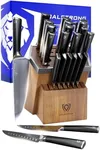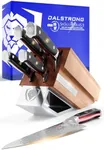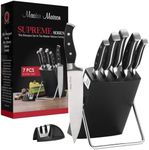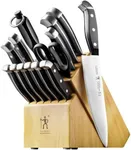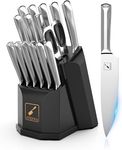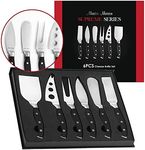Buying Guide for the Best Chef Knives Sets
Choosing the right chef knife set is crucial for any cooking enthusiast or professional chef. A good set can make food preparation easier, more efficient, and enjoyable. When selecting a chef knife set, consider the types of knives included, the materials used, and the overall quality. Here are some key specifications to help you make an informed decision.Blade MaterialThe blade material is important because it affects the knife's sharpness, durability, and ease of maintenance. Common materials include stainless steel, carbon steel, and ceramic. Stainless steel is resistant to rust and easy to maintain, making it a good choice for everyday use. Carbon steel is very sharp and holds its edge well but requires more maintenance to prevent rust. Ceramic blades are extremely sharp and lightweight but can be brittle and prone to chipping. Choose a blade material based on your preference for sharpness, maintenance, and durability.
Handle MaterialThe handle material affects the comfort and grip of the knife. Common handle materials include wood, plastic, and composite. Wooden handles offer a traditional look and feel but may require more care to prevent damage. Plastic handles are durable and easy to clean but may not provide the same level of comfort as wood. Composite handles combine the best of both worlds, offering durability and comfort. Consider how the handle feels in your hand and whether you prefer a traditional or modern look.
Knife Types IncludedA chef knife set typically includes several types of knives, such as a chef's knife, paring knife, bread knife, and utility knife. Each type of knife serves a different purpose, so it's important to have a variety to handle different tasks. A chef's knife is versatile and can be used for most cutting tasks, while a paring knife is ideal for peeling and intricate work. A bread knife has a serrated edge for slicing bread, and a utility knife is useful for smaller tasks. Consider what types of knives you need based on your cooking habits and the types of food you prepare.
Blade LengthBlade length affects the knife's versatility and ease of use. Common blade lengths for chef knives range from 6 to 12 inches. Shorter blades (6-8 inches) are easier to control and maneuver, making them ideal for smaller tasks and precision work. Longer blades (10-12 inches) are better for larger tasks and cutting through bigger items. Choose a blade length based on your comfort level and the types of tasks you perform most often in the kitchen.
Weight and BalanceThe weight and balance of a knife affect how comfortable it is to use and how well you can control it. A well-balanced knife will feel comfortable in your hand and reduce fatigue during extended use. Heavier knives can provide more power for cutting through tough items, while lighter knives are easier to maneuver for delicate tasks. Consider your personal preference for weight and balance, and try holding different knives to see what feels best for you.
Edge TypeThe edge type of a knife affects its cutting performance and maintenance. Common edge types include straight, serrated, and hollow ground. Straight edges are versatile and can be used for most tasks, but they require regular sharpening. Serrated edges are ideal for cutting through tough or crusty items like bread and require less frequent sharpening. Hollow ground edges have a concave shape that reduces friction and makes slicing easier. Choose an edge type based on the types of food you prepare and your willingness to maintain the knife.
